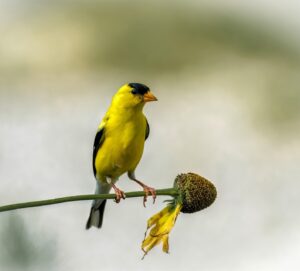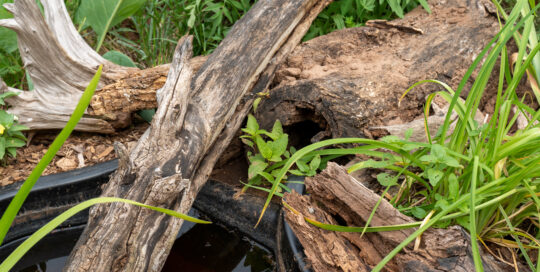Creating a Winter Wildlife Haven
Views: 193

Winter arrived earlier than usual this year, and I woke up this morning to a frosty landscape sparkling in the early sunlight. My annuals won’t survive, so many of my plants will be turning brown and dying. This time of year, we are programmed by society to tidy up our outdoor spaces by cutting down plants and raking away fallen leaves. However, this well-intentioned winter cleanup may not be the best approach for the local wildlife that depends on our gardens for survival. Leaving plants standing and leaves in place can offer significant benefits to the wildlife that call our gardens home.
Winter Shelter for Wildlife
One of the most compelling reasons to refrain from cutting down plants in winter is the shelter they provide to wildlife. The dried stems, seed heads, and even hollow canes of perennials, grasses, and shrubs offer refuge to insects, spiders, and small mammals. Ladybugs, lacewings, and butterflies might be seeking refuge in these nooks and crannies, while birds often use the stems for perching.
Additionally, some animals, such as hedgehogs, frogs, and toads, may seek out this natural cover for hibernation or overwintering. By leaving your garden’s vegetation intact, you create a safe haven for these creatures to survive the harsh winter months.
Winter Feeding Stations
The beauty of leaving plants standing in the winter is that they can still provide a food source for wildlife. Many plants produce seeds, berries, or fruits that persist through the colder months. These can be a vital source of nutrition for birds and mammals.
Birds, in particular, will appreciate the opportunity to forage on the seeds and berries left on plants like sunflowers, coneflowers, and berries. They provide a lifeline for our birds when other food sources are scarce. Already, I have pine siskins feeding on my sunflowers and giant coneflowers.
Leaf Litter as Wildlife Habitat
In addition to leaving plants standing, it’s equally important to let leaves accumulate on the ground. Leaf litter is a valuable habitat for many creatures. It provides cover for insects, spiders, and amphibians, as well as a cozy blanket for hibernating small mammals. Leaves create a moist environment that shelters these creatures from the cold and wind.
Moreover, as leaves decompose, they enrich the soil with organic matter and provide essential nutrients for the next growing season. This natural process benefits both your garden and the wildlife that depends on it.
Here’s a list of some insects that rely on leaf litter for their winter survival:
- Ladybugs: Ladybugs often seek shelter in leaf litter to hibernate during the winter months.
- Butterflies: Some butterfly species overwinter in leaf litter in their chrysalis or pupal stage. For example, the Eastern Comma butterfly.
- Moths: Many moth species pupate in leaf litter, spending the winter as pupae before emerging as adults in the spring.
- Ground Beetles: Several ground beetle species, such as the violet ground beetle, take refuge in leaf litter to survive the winter.
- Ants: Some ant species construct their nests in leaf litter, providing insulation and protection from the cold.
- Spiders: Certain spider species create overwintering sacs in leaf litter, where their eggs and young spiders are sheltered until spring.
- Dragonfly Nymphs: Dragonfly larvae (nymphs) that overwinter do so in the muck and detritus at the bottom of ponds, often covered with fallen leaves.
- Various Fly and Wasp Larvae: Several fly and wasp species lay their eggs in leaf litter, and the larvae develop there during the winter.
- Tiger Beetles: Tiger beetle larvae are known to burrow into the ground under leaf litter for protection from the cold.
- Bumblebee Queens: Bumblebee queens hibernate underground, often under leaf litter, during the winter.
Promoting Biodiversity
A garden that remains untouched during winter helps support a diverse range of wildlife species. In a time when urbanization and habitat loss threaten many animal populations, creating a haven in your own backyard is a small but important step in preserving biodiversity.
In conclusion, the temptation to prune and tidy up your garden in winter should be resisted to benefit local wildlife. By leaving plants standing and leaves in place, you provide vital shelter, food, and habitat for a variety of creatures that depend on your garden for their survival. Embracing a more natural and hands-off approach to winter gardening not only supports local wildlife but also contributes to a healthier, more balanced ecosystem in your backyard. So, let the winter garden be a wild and untamed oasis for nature’s creatures, and enjoy the beauty of the changing seasons while giving a helping hand to the wildlife that calls your garden home.
Meet Leslie Miller
Leslie Ann Miller shares 3.5 acres in rural Oklahoma with birds, butterflies and wide variety of animals. She is currently transforming her yard with plantings…
Leslie's Recent Posts

Creating microclimates and microhabitats to benefit wildlife






